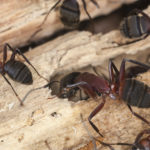
Termites Vs. Carpenter Ants: Physical Characteristics
The warm season is upon us in Utah, and that means many homeowners are thinking about pest control themes for some of the insects you tend to see more often in the spring and summer. Many of these are actually active year-round, but warmer conditions make you more likely to spot them or deal directly with them.
At Bug Busters, we’re happy to provide numerous insect control and other pest control services throughout the year. Two of the most common insect types that we’re regularly called out to assist with: Termites and ants, which are notably different in several ways but also have enough similarities that some of our clients occasionally confuse them. Using the common carpenter ant as our specific example just for the sake of simplicity, and because both are known to cause wood damage in homes, this two-part blog series will dig into the various ways you can tell the difference between ants and termites on your property. We’ll start with part one on their physical characteristics, then also dig into their behavior and why they’re a risk, plus how our exterminators will assist if you’re dealing with an infestation of either.
Body Type
Another similarity between termites and many carpenter ant formats is their size, which tends to be similar. For this reason, it’s important to look past this and pay closer attention to the actual shape and type of the body.
Specifically, look at the abdomen of the insects if you’re able to spot them. Termites will not have a “waist” of any kind, but rather will sport a rectangular look that does not get any narrower in the middle. Ants, on the other hand, have a noticeably constricted waist that’s visibly narrower than the other parts of their body, and this is often the simplest way to tell them apart.
Wings
Both the termite and the carpenter ant have four wings, but how these wings look is a major tell. Termites will show four equally-sized and equally-shaped wings, all of which are much longer than its body; a carpenter ant, meanwhile, will have hind wings that are shorter than its front wings, and both sets will be roughly proportionate to the rest of the wings. Also, ant wings are more durable and are less likely to have fallen off, while a common sign of a termite nest is loose wings.
Color Themes
Carpenter ants are red or dark-colored, and you’ll often see them out searching for food. Termite workers, meanwhile, are transparent, light or creamy, and are known to avoid light whenever possible – this sometimes makes them harder to spot.
Antennae
Finally, termites have straight, beaded antennae that are usually pretty easy to spot. Carpenter ants sport bent antennae that are clearly not straight.
For more on telling carpenter ants and termites apart, or to learn about any of our pest control services, speak to the staff at Bug Busters today.
